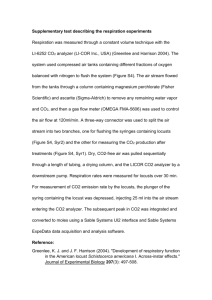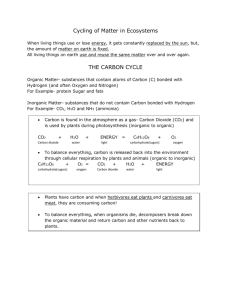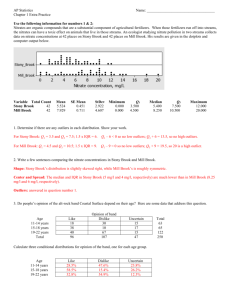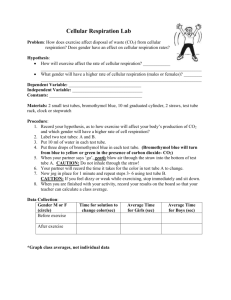Appendix A: Canopy thinning The treatment stream before canopy
advertisement
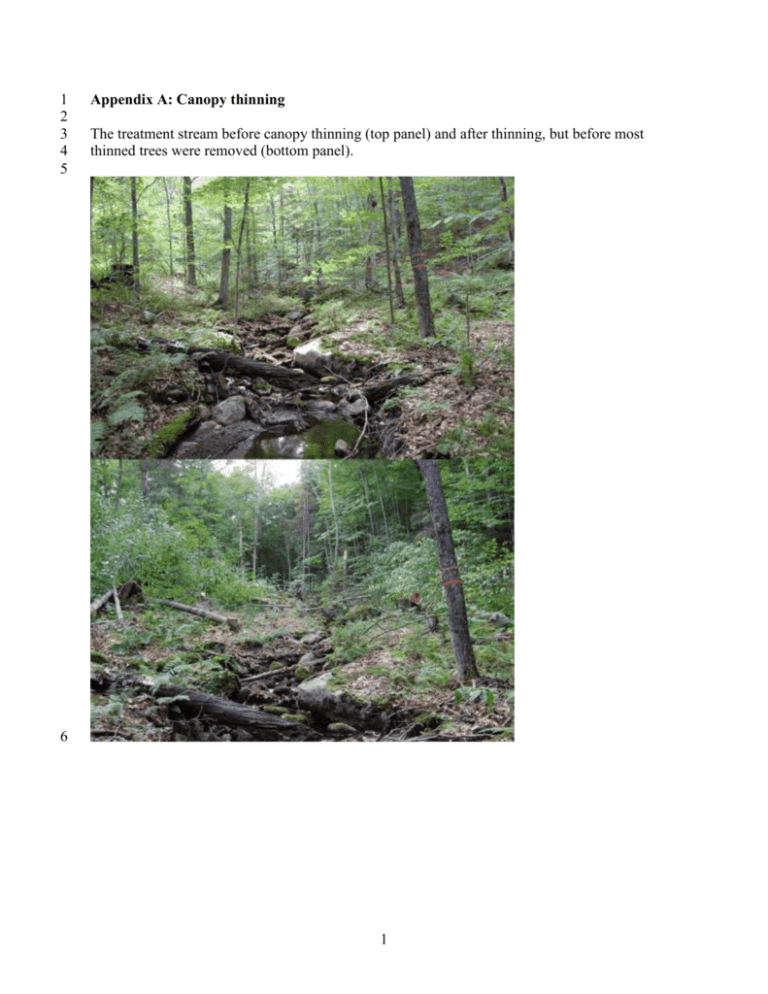
1 2 3 4 5 Appendix A: Canopy thinning The treatment stream before canopy thinning (top panel) and after thinning, but before most thinned trees were removed (bottom panel). 6 1 7 Appendix B: Methodological Details for 13CO2 Respiration Assays Laboratory and field respiration assays allowed for successful measurement of 13C of live 8 9 bacterial biomass. We added HgCl2 as a kill control in field sampling during isotope tracer 10 releases, but control respiration incubation treatments in which all live organisms were killed 11 with HgCl2 produced the same amount of CO2 as live treatments, or even more CO2 than live 12 treatments, but showed no enrichment beyond background. These results indicated that the 13CO2 13 in the headspace of live treatments was a product of bacterial respiration, not inorganic diffusion 14 (Figure 1). We could not use the concentration data from original incubations because of 15 problems with HgCl2 effects on CO2 concentrations, so we conducted additional experiments 16 (detailed below) to parameterize models with concentration data. 17 18 19 20 21 22 23 24 25 Figure 1: Live versus killed CO2 respiration treatments from the 2009 tracer release in the reference stream. Live treatments from 10 m downstream of the point of isotope addition (most enriched sampling site) and 30 m downstream of the point of isotope addition (moderately enriched sampling site) are shown with data from incubations in which microbes were killed with HgCl2. HgCl2 treatments produced as much CO2 as live treatments, but never showed any evidence of isotopic enrichment, demonstrating that labeled CO2 in the headspace is a product of respiration. 100 10m 30m Kill d13C 75 50 25 0 1 4 7 Hours 26 2 27 28 Estimates of [CO2] for 13CO2 mixing model We used field experiments to estimate information needed for the 13CO2 mixing model 29 that we used to calculate 13CO2 that was respired by bacteria. We ran 16 concurrent incubations 30 in sealed mason jars in the each study stream using the same methods as we did for field 31 incubations during the isotope tracer releases. In each stream, 8 jars contained coarse benthic 32 organic material (leaves) and 8 contained fine benthic organic matter (sediment). Of the 8 jars 33 for each type of organic matter, 4 were untreated and 4 were treated with sodium azide to kill all 34 microorganisms and stop respiration. From this experiment, we were able to calculate δ13C of 35 CO2 from inorganic sources (that is, not from respiration) by measuring δ13C of headspace CO2 36 in sodium azide treatments. We were also able to infer the proportion of headspace CO2 that was 37 derived from inorganic sources based on the ratio of [CO2] in treatments with sodium azide over 38 [CO2] in treatments with both inorganic diffusion and respiration. We calculated the proportion 39 of headspace CO2 from respiration by difference. Those data provided the information needed 40 for our mixing model that is described in the methods section of the paper. Values we calculated 41 from the experiment and used in the mixing model are detailed below in a table. We also 42 corrected to account for the fact that both bacterial and fungal respiration contribute to the 43 organic/respiration fraction of CO2 in the incubation headspace (f organic). We estimated a ratio 44 of respiration due to bacteria versus fungi in each organic matter type based on literature values 45 from other systems (described in the methods section) and used that ratio to correct f organic to 46 find f bacteria. 47 48 49 Stream Blues Brook Blues Brook Combs Brook Combs Brook Organic Matter Type f inorganic Coarse (leaves) 0.83 Fine (sediment) 0.81 Coarse (leaves) 0.86 Fine (sediment) 0.79 f organic 0.17 0.19 0.14 0.21 3 δ 13C inorganic bacteria:fungi f bacteria -23.5 1 to 10 0.02 -23.5 1 to 1 0.10 -22.8 1 to 10 0.01 -22.8 1 to 1 0.11 50 We also used data for δ13C of CO2 from our field incubations during the isotope tracer release as 51 an estimate of the total CO2 pool (both respiration and inorganic). We collected data on the three 52 sampling days during the course of the 10-day isotope drip (Days 3, 7, 10) and during the 53 sampling day following the isotope drip (Day 14). Data for δ13C of CO2 at the two sampling 54 stations (10 m downstream of the point of isotope addition and 30 m downstream of the point of 55 isotope addition) are summarized in the following table. 56 57 Stream Organic Matter Type Combs Brook Combs Brook Blues Brook Blues Brook Combs Brook Combs Brook Blues Brook Blues Brook Combs Brook Combs Brook Blues Brook Blues Brook Combs Brook Combs Brook Blues Brook Blues Brook Coarse (leaves) Coarse (leaves) Coarse (leaves) Coarse (leaves) Fine (sediment) Fine (sediment) Fine (sediment) Fine (sediment) Coarse (leaves) Coarse (leaves) Coarse (leaves) Coarse (leaves) Fine (sediment) Fine (sediment) Fine (sediment) Fine (sediment) Downstream Distance 10 30 10 30 10 30 10 30 10 30 10 30 10 30 10 30 Year δ 13C Day 3 δ 13C Day 7 δ 13C Day 10 δ 13C Day 14 2009 2009 2009 2009 2009 2009 2009 2009 2010 2010 2010 2010 2010 2010 2010 2010 29.3 -4.1 104.3 -0.6 1.7 -9.4 29.1 -0.5 44.2 -7.7 57.3 18.1 -1.0 -4.3 -0.4 -8.5 96.7 49.2 72.4 46.4 0.2 -6.6 37.8 13.2 104.3 2.2 543.6 34.3 -0.3 -4.2 6.1 10.6 74.7 2.5 70.8 20.1 0.5 -0.5 25.4 15.2 20.8 -11.6 314.7 104.1 -5.1 -12.1 41.2 17.6 -4.1 4.2 -0.5 -4.3 -8.1 -11.3 13.3 -5.2 -6.7 -17.8 9.9 -7.6 -14.7 -13.0 -9.6 -9.6 4 58 Appendix C: Detailed description of dynamic compartment model for estimating consumer 59 turnover times 60 61 We used a linked dynamic compartment model approach based on observed isotopic 62 enrichment of food (food pool, or FP) and consumers (consumer pool, or CP). We collected data 63 during the 10 days that the system was enriched with tracer 15N and 13C and for 20 days after the 64 addition stopped and 15N and 13C declined. From this point forward, we describe terms of the 65 model for N for the sake of simplicity, but 13C and 12C could be used throughout the model 66 instead of 15N and 14N. This model is also described in detail in Dodds and others (2014). 67 We tracked the mass of each isotope (either 15N and 14N) over time in each pool and 68 gains and losses of isotopes were based on uptake (U15N and U14N) and loss (L15N and L14N) of 69 both isotopes expressed as mass per unit area per unit time (t). These uptake and loss fluxes were 70 calculated by tracking the 15N and 14N in the consumer pool (CP15N and CP14N, respectively) as a 71 function of the δ15N of up to three potential food pools labeled a, b, and c (FPδ15N,a ; FPδ15N,b; 72 FPδ15N,c). 73 The composite food pool δ15N (𝐹𝑃𝛿15𝑁 ) was estimated by weighting the δ15N of 74 individual diet sources (𝐹𝑃𝛿15𝑁,𝑎 ) by the proportion of that food source in the consumer diet (𝑃𝑎 ; 75 Eq. 1). The proportion of each food source was estimated using prior knowledge of consumer 76 diets or by functional feeding group classification. For organisms that were presumed to eat 77 fewer than three food sources, the number of sources was reduced accordingly. 𝐹𝑃𝛿15𝑁 = 𝐹𝑃𝛿15𝑁,𝑎 × 𝑃𝑎 + 𝐹𝑃𝛿15𝑁,𝑏 × 𝑃𝑏 + 𝐹𝑃𝛿15𝑁,𝑐 × 𝑃𝑐 78 79 (1) 5 80 The 15N atomic ratios of the FP (ARFP) and CP (ARCP) were calculated from δ15N values to 81 allow separate mass-balance tracking of 15N and 14N based on the ratio of 15N and 14N in the 82 atmosphere of 0.003663: 𝐴𝑅𝐹𝑃 = 𝐹𝑃 83 𝐹𝑃15𝑁 14𝑁 + 𝐹𝑃15𝑁 = (𝐹𝑃𝛿15𝑁 /1000) × 0.003663 + 0.003663 (2) 84 At each sampling point, the 15N and 14N fluxes into the consumer pool were assumed to be 85 proportional to the atomic ratio of the food pool(s), and N uptake and loss were the sum of the 86 15 87 N and 14N uptake rates (U15N and U14N , respectively): 𝑈 = 𝑈15𝑁 + 𝑈14𝑁 (3) 88 We used the change in the consumer pool of 15N between time steps 1 and 2, representing the 89 time between sampling, to calculate the new size of the consumer pool at time step 2 (CP15N, t=2) 90 from net uptake, which depends on ARFP and the uptake from the FP over time (t) as well as the 91 loss from the CP (L), the atomic ratio of the consumer pool (ARCP), and time (Eq. 4): 92 93 94 𝐶𝑃15𝑁,𝑡=2 = 𝐶𝑃15𝑁,𝑡=1 + (𝑈 × 𝐴𝑅𝐹𝑃 × 𝑡) − (𝐿 × 𝐴𝑅𝐶𝑃 × 𝑡) (4) Similarly, net uptake of 14N was calculated as: 𝐶𝑃14𝑁,𝑡=2 = 𝐶𝑃14𝑁,𝑡=1 + [𝑈 × (1 − 𝐴𝑅𝐹𝑃) × 𝑡] − [𝐿 × (1 − 𝐴𝑅𝐶𝑃) × 𝑡] (5) 95 The calculated ARCP can lead to model instability if the time steps are too large (i.e., many days 96 between samples). Thus, ARCP was reset to the observed value at each sampled time step in the 97 model. In our study systems, biomass of CP was constant over the time period, then U = L. 98 We created a multiplier (M) to evaluate the degree to which we were not accounting for 99 δ15N label mismatch in the food pool by adjusting the peak food source label to fit the observed 100 peak animal isotopic signal. The bounds on the range of M values were set such that the lowest 101 possible value for M adjusted the food source to match the δ15N of its consumer (CP15N/FP15N). 6 102 In contrast, the highest M value was dependent on the measured or calculated δ15N-NH4+ in the 103 water column during the experiment (water15N/FP15N). 104 The model was created in Microsoft Excel and the “Solver” function was used to fit 105 observed to modeled values of δ15N by minimizing the sum of square of errors and changing U, 106 U/L, and M. Because there was no change in biomass over the experiment, U/L was set to 1. We 107 observed the model output graphically to assess the quality of fit. 108 7

